Chapter 4.2 - Electrical Power and Household Circuits Exercise 187
Question 1
Define electric power. What do you mean by 'power rating' of an electric appliance?
Solution 1
Electrical power is defined as the rate at which energy is changed or work is done i.e., the work done per second or energy converted per second.
Electrical appliances come with certain number of watts and volts written on them. Power rating of an electrical appliance gives the knowledge of the safe current limit of an appliance and also indicates the voltage above which the appliance should not be used.
Electrical appliances come with certain number of watts and volts written on them. Power rating of an electrical appliance gives the knowledge of the safe current limit of an appliance and also indicates the voltage above which the appliance should not be used.
Question 2
State two characteristics of a fuse wire.
Solution 2
Characteristics of fuse wire:
(i) It should have low melting point.
(ii) It should have high resistance.
(i) It should have low melting point.
(ii) It should have high resistance.
Question 3
Complete the following sentences:
(i) A fuse is a short piece of wire of high ......... and low
(ii) Fuse wire has a . Melting point and it is made of an alloy of ......... and if the current in a circuit rises too high, the fuse wire
(iii) A fuse is connected in (parallel/series) with the ......... (earth/neutral/live) wire.
(i) A fuse is a short piece of wire of high ......... and low
(ii) Fuse wire has a . Melting point and it is made of an alloy of ......... and if the current in a circuit rises too high, the fuse wire
(iii) A fuse is connected in (parallel/series) with the ......... (earth/neutral/live) wire.
Solution 3
(i) resistance, melting point
(ii) low, lead, tin, melts.
(iii) series, live
(ii) low, lead, tin, melts.
(iii) series, live
Question 4
Distinguish between electric power and electrical energy. State their units. Give the other name of kWh.
Solution 4

Question 5

Solution 5
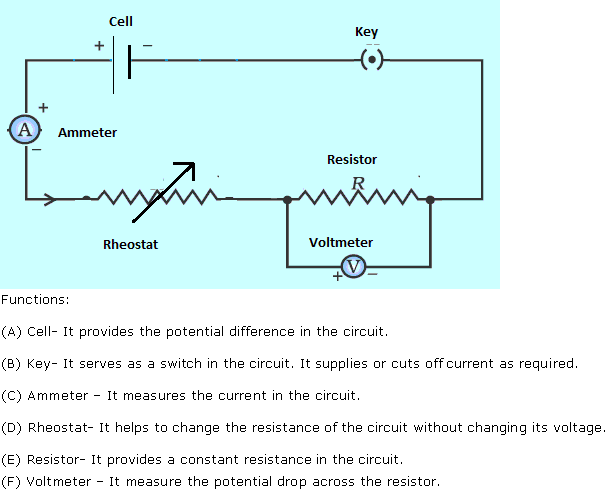
Question 6
Explain the meaning of the statement 'the current rating of a fuse is 5 A'.
Solution 6
'The current rating of a fuse is 5 A' means that the maximum safe current permitted to flow through it before it breaks down is 5A.
Question 7
'A fuse is rated 8 A'. Can it be used with an electrical appliance of rating 5 kW, 200 V?
Solution 7

Question 8
An electric kettle is rated 3 kW, 250 V. Give reason whether this kettle can be used in a circuit which contains a 13 A fuse.
Solution 8

Question 9
Calculate the electric current supplied by a 12 V battery of an automobile to a starter that develops a power of 2.4 kW.
Solution 9
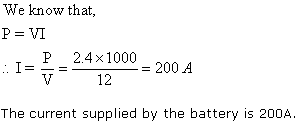
Question 10
A 720 W heater operates from a 220 V line voltage. Calculate:
(a) The electrical energy consumed by the heater in 3 h.
(b) The cost of electrical energy consumption at the rate of 60 paise per kWh.
(a) The electrical energy consumed by the heater in 3 h.
(b) The cost of electrical energy consumption at the rate of 60 paise per kWh.
Solution 10

Question 11
What is fuse? Name the material of fuse.
Solution 11
An electric fuse is a safety device which is used to limit the current in an electric circuit. The use of a fuse thus safeguards the circuit and appliances connected in that circuit from being damaged.
A fuse is generally made of an alloy of lead and tin.
A fuse is generally made of an alloy of lead and tin.
Chapter 4.2 - Electrical Power and Household Circuits Exercise 188
Question 1
Solution 1

Question 2
A 200 v electric transfer draws an electric current of 11 A. What is its electrical resistance?
Solution 2
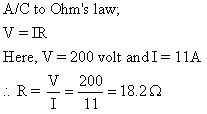
Question 3
A heater is rated at 1200 W when the electric current is 5 A. Calculate the resistance and the potential difference.
Solution 3
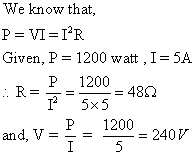
Question 4
Where is the main fuse in a house circuit connected?
Solution 4
The main fuse is connected between the kWh meter and distribution board of the house circuit. The main fuse is connected in the live wire.
Question 5
Is kWh the unit of electrical energy?
Solution 5
Yes, kWh is the unit of electrical energy.
Question 6
What is the purpose of a switch in a circuit? Why is the switch put in the live wire?
Solution 6
A switch is an on-off device for current in a circuit (or in an appliance). Its main function is either to connect or to disconnect an electrical appliance in an electric circuit.
Switches are always connected in the live wire of circuits so that when a switch is in 'off' position, no current flows through the appliance and its live and neutral wires are at same potential and it is safe to touch the live wire leading to the appliance, even when the fuse is blown.
Switches are always connected in the live wire of circuits so that when a switch is in 'off' position, no current flows through the appliance and its live and neutral wires are at same potential and it is safe to touch the live wire leading to the appliance, even when the fuse is blown.
Question 7
A switch is not touched with wet hands while putting it on or off. Give a reason for your answer.
Solution 7
A switch should not be touched with wet hands. This is because water forms a conducting layer between the hand and the live wire of the switch through which the current passes to the hand and we may get a fatal shock.
Question 8
An electric bulb is rated 250 W, 230 V. What information does this convey? Calculate the current through a 60 W lamp rated for 250 V. If the line voltage falls to 200 V, how is the power consumed by the bulb affected?
Solution 8
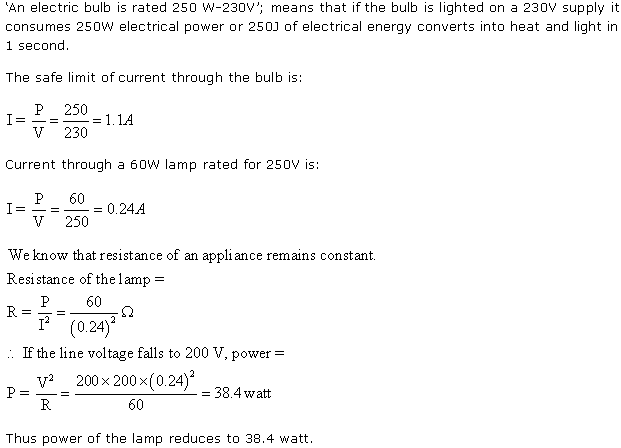
Question 9
The metal case of an electric appliance is earthed. Explain the reason.
Solution 9
The metal case of an electrical appliance is earthed so that in any case of accidental contact of live wire with the metallic body of the appliance, the earthing would provide a safe and easy path for the electric charges to flow down to the earth which acts as very large sink. Thus, user is thereby protected from any fatal electric shock.
Question 10
A bulb marked 12 V, 24 W operates on a 12 volt car battery for 20 minutes. Calculate:
(i) The current flowing through it, and
(ii) The energy liberated.
(i) The current flowing through it, and
(ii) The energy liberated.
Solution 10

Question 11
What is international convention of colour coding in a cable?
Solution 11
International convention of colour coding:
1. Live wire - Brown
2. Neutral wire - Light blue
3. Earth wire - Green or yellow
1. Live wire - Brown
2. Neutral wire - Light blue
3. Earth wire - Green or yellow
Question 12
A current of 0.2 A flows through a wire whose ends are at a potential difference of 15 V. Calculate:
(i) The resistance of the wire, and
(ii) The heat energy produced in 1 minute.
(i) The resistance of the wire, and
(ii) The heat energy produced in 1 minute.
Solution 12
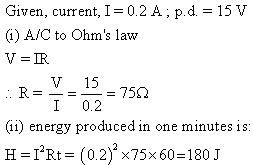
Question 13
What should be the current rating of a fuse to be used with an electric appliance of rating 1.5 kW-220 V? How is the fuse connected with the appliance?
Solution 13

Question 14
Explain briefly how a fuse protects an electric circuit.
Solution 14
The fuse helps to control the maximum current in an electrical circuit. The fuse protects an electrical circuit by melting and breaking the circuit, whenever the current exceeds the pre-determined limit in the circuit. Due to low melting point, the fuse wire melts and then breaks the circuit.
Question 15
Why is earthing done?
Solution 15
Earthing is done to save an electrical circuit or an appliance from damage. If due to some reason such as short circuiting, an excessive current flows through the line wires, it will pass to the earth if there is local earthing, otherwise it may cause a fire due to overheating of line wires.
Question 16
Draw a labeled diagram of a three pin socket.
Solution 16
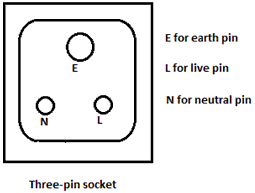
Question 17
Under what circumstances does one get an electric shock from an electrical gadget?
Solution 17
One may get an electric shock from an electrical appliance if accidentally the live wire comes in contact with the metallic case of the body of the appliance due to break of insulation after constant use (or otherwise).
Question 18
State the S.I. units of electrical power and electrical energy.
(i) Define the household unit of electricity.
(ii) What is the voltage of the electricity that is generally supplied to a house?
(i) Define the household unit of electricity.
(ii) What is the voltage of the electricity that is generally supplied to a house?
Solution 18
The SI unit of electrical energy is joule.
The SI unit of electrical power is watt.
(i) Kilowatt-hour is the household unit of electrical energy. It is defined as the quantity of electrical energy consumed in 1 hour when the rate of consumption is 1000 watts, i.e. 1000 J/s.
(ii) A voltage of 220 volt is generally supplied to a house.
The SI unit of electrical power is watt.
(i) Kilowatt-hour is the household unit of electrical energy. It is defined as the quantity of electrical energy consumed in 1 hour when the rate of consumption is 1000 watts, i.e. 1000 J/s.
(ii) A voltage of 220 volt is generally supplied to a house.
Question 19
An electric bulb is rated at 220 V, 100 W. What is its resistance? What maximum current can be passed through it?
Solution 19
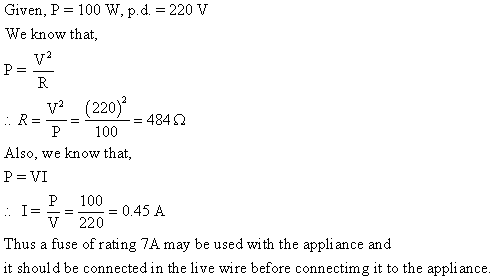
Question 20

Solution 20
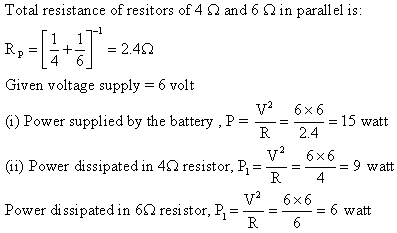
Question 21
What purpose is served by the terminals of a three way pin plug?
Solution 21
A three pin-plug has three terminals:
(i) Earth pin: It provides connection for earthing.
(ii) Neutral pin: It provides connection to the neutral wire.
(iii) live pin: It provides connection to the live wire.
(i) Earth pin: It provides connection for earthing.
(ii) Neutral pin: It provides connection to the neutral wire.
(iii) live pin: It provides connection to the live wire.
Question 22
Name the unit which a consumer pays as the cost of electricity.
Solution 22
Consumer pays the bill in kilowatt-hour.
Question 23

Solution 23
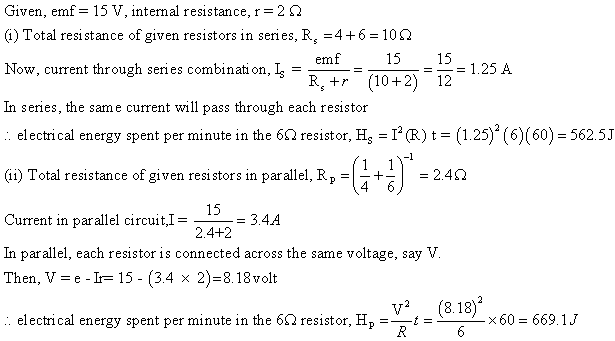
Question 24
State the commercial unit of electrical energy.
Solution 24
Kilowatt-hour is the commercial unit of electricity.
Question 25
Write different expressions for electric power (P), using V, I and R.
Solution 25
Question 26
What do you mean by 'power-voltage' rating of electrical appliances?
Solution 26
Power-voltage rating of an electrical appliance indicates the value of voltage above which the appliance should not be used. It serves as a precaution to the customer and also helps to calculate the maximum value of current that can be safely passed through the appliance.
Question 27
Name the physical quantity which equals the product of voltage and current.
Solution 27
The physical quantity is electric power.
Question 28
The marking on an electric bulb reads; 200 V, 60 W. What does it mean?
Solution 28
It means that if the bulb is lighted on a 200V supply it consumes 60W electrical power or 200J of electrical energy converts into heat and light in 1 second.
Question 29
The resistance of 100 W (220 V) bulb is greater than that of 60 W (220 V) bulb. Is it true or false?
Solution 29

Chapter 4.2 - Electrical Power and Household Circuits Exercise 189
Question 1
What will be the current drawn by an electric bulb of 40 W when it is connected to a source of 220 V?
Solution 1

Question 2
What do you mean by watt-hour?
Solution 2
Watt-hour is the commercial unit of electrical energy.
One watt-hour is the electrical energy consumed by an electrical appliance of power 1 watt when it is used for 1 hour.
1Wh = 3600 J
One watt-hour is the electrical energy consumed by an electrical appliance of power 1 watt when it is used for 1 hour.
1Wh = 3600 J
Question 3
Name the commercial unit of electrical energy.
Solution 3
Kilowatt-hour is the commercial unit of electricity.
Question 4
A radio set of 60 W runs for 50 hours. How much electrical energy is consumed? Give your answer in kWh.
Solution 4

Question 5
In a house two 60 W electric bulbs are lighted for 4 hours, and three 100 W bulbs for 5 hours every day. How much is the electric energy consumed during the month of June?
Solution 5


0 comments:
Post a Comment